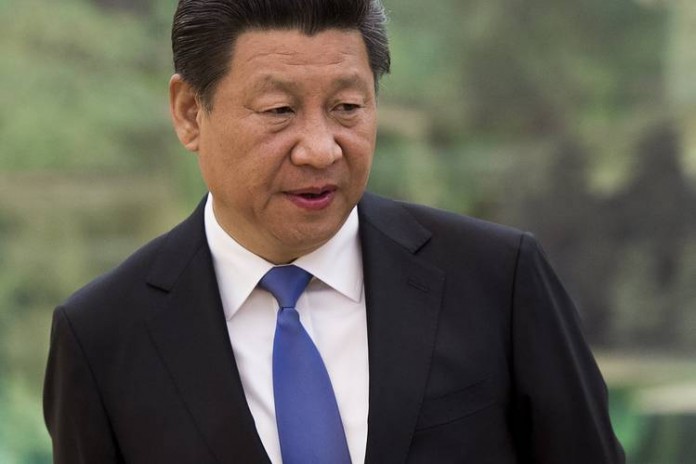
President Donald Trump said on Twitter on Wednesday night that he would delay by two weeks the next increase in tariffs on Chinese goods as a “gesture of good will” to advance trade talks that have made little progress for months.
The president acted several hours after a conciliatory Chinese move to grant 16 U.S. products a one-year exemption from Beijing’s retaliatory tariffs. In a pair of tweets, Trump said he delayed his scheduled Oct. 1 increase at the request of China’s chief trade negotiator, Vice Premier Liu He, to avoid imposing the tariffs as the People’s Republic of China celebrated its 70th anniversary.
Oct. 1 is a politically sensitive date on the Chinese calendar in any year, but President Xi Jinping has been preparing for an elaborate celebration this year to showcase the country’s emergence as a global power. Liu is expected to lead a Chinese delegation to Washington for the resumption of the stalled trade talks some time next month.
“This is a response to the Chinese goodwill gesture,” said Michael Pillsbury of the Hudson Institute, who has advised the administration on China. “This is goodwill gesture for goodwill gesture.”
Still, U.S.-China relations remain fraught. On Sept. 1, the United States imposed a 15 percent tariff on an additional $112 billion of Chinese goods, the first step toward taxing almost all Chinese imports by mid-December. And for now, the next increase has only been delayed not canceled. On Oct. 15, the United States now plans to raise to 30 percent from 25 percent its import levy on $250 billion worth of Chinese products.
Business groups remain wary of the trade war’s dangers. “It’s a nice gesture to see the delay in tariffs given significance of October 1st to China but we remain focus on the upcoming high level talks in early October and desire for signs that the talks will be productive,” Myron Brilliant, executive vice president of the U.S. Chamber of Commerce, who was visiting Beijing, said via email.
Some experts were harshly critical of the administration for originally planning the tariff increase for a date of such symbolic importance to the Chinese. “That was a provocative insult to the Chinese side,” said Susan Shirk, a former U.S. diplomat in the Clinton administration and now head of the 21st Century China Center at the University of California at San Diego. “This reflects the fact that the administration is basically incompetent when it comes to actually getting things done, negotiating and really inducing China to make the changes we seek.”
Mid-level U.S. and Chinese officials have begun discussing the next round of ministerial talks between Liu and Robert Lighthizer, the chief U.S. trade representative, which are scheduled for October. No date has yet been agreed and the two sides remain divided on numerous key issues.
The president has been seeking a comprehensive trade deal involving huge new Chinese purchases of American industrial and agricultural goods as well as structural changes in China’s state-directed economic model.
Few analysts are optimistic about an early breakthrough.
“The brevity of the delay is clearly intended to signal that the Trump administration has no intention of easing the tariff pressures unless China is willing to make significant concessions in the upcoming talks,” Eswar Prasad, former head of the International Monetary Fund’s China division, said via email. “This modest concession from Trump could give the Chinese government a bit of domestic maneuvering room in the next round of negotiations. But the path to any sort of deal is still strewn with many major obstacles and this concession by Trump doesn’t change the fundamentally unfavorable dynamics of the trade talks.”
China’s act to exempt certain products earlier Wednesday, which Beijing said was designed to ease the dispute’s impact on American companies, does not offer relief from tariffs on the big-ticket agricultural products such as soybeans and corn that are causing the most hurt in the United States.
“China wants to claim the moral high ground before the October talks and to send a message of goodwill,” said Yao Xinchao, professor of international trade at the University of International Business and Economics in Beijing. “It’s all about molding public opinion” to portray the United States as the aggressor, Yao added.
China’s Ministry of Finance said that 16 types of U.S. products would be exempt from retaliatory tariffs for a year from Tuesday. The list included varieties of animal feed such as alfalfa and fish meal, cancer drugs gefitinib and capecitabine, base oil for lubricants and lubricating grease, and some farm chemicals.
Further exemptions will be announced in the coming weeks, the ministry said, and tariffs that have beenimposed will be refunded.
“The purpose is to minimize the impact of economic and trade frictions on Chinese enterprises, and to show China’s consistent calmness and rationality in dealing with these frictions,” the state news agency, Xinhua, wrote in a commentary published Wednesday evening. It characterized China as “highly responsible.”
But the list offers no respite for American farmers affected by Chinese tariffs on products including corn, soybeans and pork. Exports of American agricultural products have been hit especially hard in the trade war – the Chinese duty on American pork now sits at 72 percent – leading the Trump administration to offer compensation to American farmers to the tune of $28 billion.
China knows that this represents a point of leverage: The trade war is playing out in rural America ahead of an election year.
“Pork and soybeans are two important bargaining chips that China won’t play easily,” Yao said.
Wednesday’s measures marked the first time in the dispute that tariffs have been removed, not added.
“I think both sides want a deal,” said Kent Kedl, a China analyst at the Control Risks consultancy. “So I think they’re trying to feel their way around and find out what might break the stalemate. China is speaking the language of the Trump administration here: tariffs.”
China and the United States have been involved in a tit-for-tat tariff battle, imposing rounds of duties on each other’s products for more than a year.
Trump has hoped that the tariffs would convince China to cave in to his demands to rebalance the trading relationship between the world’s two largest economies. But Beijing has retaliated as much as it can – China exports far more to the United States than it imports – and has insisted any deal must be “mutually beneficial.”
In the current episode, the Trump administration declared it would add a 15 percent tax to consumer products from China, including clothing, footwear, pens, pencils, diapers, Bluetooth ear buds, televisions, golf clubs and fishing line. Those tariffs took effect Sept. 1.
At one point, Trump even ordered American companies to prepare to leave China.
The trade war is taking its toll on the world’s two largest economies. The growth rate in China has slowed to its weakest level in 30 years, and although this is mostly due to domestic factors, the trade war is certainly not helping.
Imports of American goods to China fell by 22 percent in August compared with a year earlier, according to Chinese customs data published Sunday. Meanwhile, the value of Chinese exports to the United States fell by 16 percent.
By the same token, the U.S. economy is also showing signs of weakness, as the Federal Reserve highlighted in July when it cut interest rates. Surveys have shown cause for concern about the U.S. manufacturing sector in particular.
But efforts to broker a deal to end the trade war have repeatedly failed, with China balking at what it considers American micromanagement – requiring legal changes that it says are unnecessary – while the United States remains skeptical that China will embark on the kinds of structural changes it says are needed.
American negotiators have been pushing China to do more to protect intellectual property rights and stop Chinese companies from forcing American partners to hand over technology as the price of market entry. They also want China to create a more level playing field by limiting its support for state-owned enterprises.
Trump has been particularly concerned about the trade deficit with China – which widened to $419 billion last year – and has been pressing Beijing to buy more from the United States as a way to close that gap.
In the latest effort to find a solution, China’s Commerce Ministry said last week that Liu would travel to Washington in early October for a new round of talks aimed at breaking the impasse.
This will be the 13th round of talks between Liu and Lighthizer.
Andrew Collier, managing director of Orient Capital Research in Hong Kong, said that China appeared to be sending a signal to Trump to get the talks moving forward.
“It sounds like they scrambled at the last minute to put together a list of tariffed items that wouldn’t significantly change their negotiating stance but would at least show they were willing to compromise,” Collier said. “It’s very much an improvised strategy.”
But the biggest challenge, said Kedl of Control Risks, will be getting to a position where the two sides can trust each other again.
“They need to be able to look each other in the eye and know that 48 hours later, they will still be in agreement,” he said, referring to some of the previous U-turns in the talks.
Businesses on both sides are eager for an end to the protracted conflict and the uncertainty that it has injected into the trading relationship.
A U.S. Chamber of Commerce delegation led by Brilliant has been in Beijing this week holding talks with senior Chinese leaders, including Premier Li Keqiang. The tariff dispute has dragged down economic growth and business confidence, Brilliant said after meeting with Li.
“The uncertainty produced by U.S.-China trade tensions is exerting significant downward pressure on both economies,” Brilliant said in a statement. “The time is now to strike a deal that addresses the U.S.’s legitimate concerns about market access, forced technology transfer, subsidies, and digital trade, while concurrently removing punitive and retaliatory tariffs.”
Li, for his part, said the two sides should seek common ground based on the principle of equality and mutual respect, according to a report from China’s state-run Xinhua news agency.
(c) 2019, The Washington Post · David J. Lynch, Anna Fifield
{Matzav.com}











